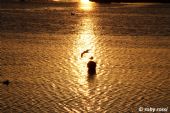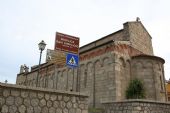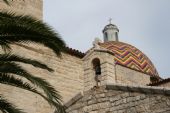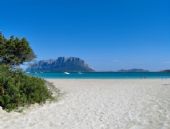
Olbia
surprisingly Tourism
Located on the Gulf, with the wide and deep natural harbor with 2500 years of history, Olbia is the maritime station of the White Island the ideal landing place to and from the Continent, which is about 250 km. (7/9 hours of navigation; 5/6 hours with fast ferries).
Coming from the sea the view is striking for its unique beauty, and the south sees the majestic silhouette of Tavolara.
Goal of international flows, increased from the Costa Smeralda, the city continues to expand, gravity around tourism activities, port traffic and the growing reality of the tertiary sector.
Despite the name (Olbios = happy) recalls Greek origins, are the most reliable ones Phoenician-Punic (V century BC.). In Roman times, the city was an important trading center with a busy port from which ships arrived and departed for the supply of goods to and from the capital. Starting from the Mille Olbia appears with the name of Civita as episcopal and as the capital of Judicature of Gallura.
In the fourteenth century. passes under the domain Aragonese with the name of Newfoundland, which holds up to 1939 when it returns to call Olbia.
The current image of Olbia, no longer relegated to just "transit place", as it has seen the redevelopment of the urban front-port with a series of public works such as the Tunnel, the National Archaeological Museum and the Theatre, overlooking the Gulf, the latter characterized by the typical crops of mussels.
The historical center, adjacent to the promenade and the Old Port, is built around the promenade of Corso Umberto, Piazza Margherita Piazza Matteotti, with suggestive corners like the typical district of Sa Wrinkles; the center also branches Viale Aldo Moro, modern shopping street that connects with Arzachena and the entire coast.
In the center there is the Church of St. Pietro and Paolo, the Town Hall, the Municipal Library Simpliciana and the former hotel Italy today Olbia Expo; walk you can reach the Punic Walls, in Via Torino, the Punic vestiges found in Via Nanni, the remains of the Roman Aqueduct, in Via delle Terme, and the beautiful Basilica of San Simplicio, the former cathedral of Judicature of Gallura, in Romanesque style built in the eleventh century and completed between the second and third decades of the century. XII.
Nearby interesting visits to the ruins of the castle of Pedres, south of the city toward Loiri (XII sec.) To walk here is the Giant's Tomb of Su Monte de s'Ape (XVI-XVIII century BC.).
Passing the railway bridge to the Golfo Aranci, they are visible remnants of Sa Rughittula Roman aqueduct, built between I and II sec. AD, the best preserved example in Sardinia between those built in Roman times.
Continuing on the same road, to the north, it is the Fortress nuragica of Cabu Abbas, adjacent to the homonymous country church.
After about 3 km. along the coast road to Golfo Aranci, on the right, the Pozzo Sacro of Sa Testa (II century BC.).
About 5 km. from Olbia, inland through the Castle Sa Paulazza (or Mont'a Telti) due at the time after the reconquest of the island under the Emperor Justinian (534 AD).
A visit to the River Park Padrongianus, leaving the city heading south for Murta Maria, turning right after the bridge over the river.
The Park is a site of considerable natural value and landscape, for the protection and conservation of animal and plant species, as well as having a significant interest from the point of view of tourism.
Enjoy leisurely walks in the open air, trekking and light hiking, archery, canoeing and kayaking, mountain-bike rental, observe nature and the many species of birds found in the form sedentary or migratory ("bird- watching "), participate in educational workshops for children and adults; participate in competitions of Nordic walking (with certified instructors ANWI), of archery (there is also a special field), kayak, organized by local sports clubs.
There are also green areas suitable for children to play and for the picnic, as well as a small collection of scientific and promotional publications of the territory.
Coming from the sea the view is striking for its unique beauty, and the south sees the majestic silhouette of Tavolara.
Goal of international flows, increased from the Costa Smeralda, the city continues to expand, gravity around tourism activities, port traffic and the growing reality of the tertiary sector.
Despite the name (Olbios = happy) recalls Greek origins, are the most reliable ones Phoenician-Punic (V century BC.). In Roman times, the city was an important trading center with a busy port from which ships arrived and departed for the supply of goods to and from the capital. Starting from the Mille Olbia appears with the name of Civita as episcopal and as the capital of Judicature of Gallura.
In the fourteenth century. passes under the domain Aragonese with the name of Newfoundland, which holds up to 1939 when it returns to call Olbia.
The current image of Olbia, no longer relegated to just "transit place", as it has seen the redevelopment of the urban front-port with a series of public works such as the Tunnel, the National Archaeological Museum and the Theatre, overlooking the Gulf, the latter characterized by the typical crops of mussels.
The historical center, adjacent to the promenade and the Old Port, is built around the promenade of Corso Umberto, Piazza Margherita Piazza Matteotti, with suggestive corners like the typical district of Sa Wrinkles; the center also branches Viale Aldo Moro, modern shopping street that connects with Arzachena and the entire coast.
In the center there is the Church of St. Pietro and Paolo, the Town Hall, the Municipal Library Simpliciana and the former hotel Italy today Olbia Expo; walk you can reach the Punic Walls, in Via Torino, the Punic vestiges found in Via Nanni, the remains of the Roman Aqueduct, in Via delle Terme, and the beautiful Basilica of San Simplicio, the former cathedral of Judicature of Gallura, in Romanesque style built in the eleventh century and completed between the second and third decades of the century. XII.
Nearby interesting visits to the ruins of the castle of Pedres, south of the city toward Loiri (XII sec.) To walk here is the Giant's Tomb of Su Monte de s'Ape (XVI-XVIII century BC.).
Passing the railway bridge to the Golfo Aranci, they are visible remnants of Sa Rughittula Roman aqueduct, built between I and II sec. AD, the best preserved example in Sardinia between those built in Roman times.
Continuing on the same road, to the north, it is the Fortress nuragica of Cabu Abbas, adjacent to the homonymous country church.
After about 3 km. along the coast road to Golfo Aranci, on the right, the Pozzo Sacro of Sa Testa (II century BC.).
About 5 km. from Olbia, inland through the Castle Sa Paulazza (or Mont'a Telti) due at the time after the reconquest of the island under the Emperor Justinian (534 AD).
A visit to the River Park Padrongianus, leaving the city heading south for Murta Maria, turning right after the bridge over the river.
The Park is a site of considerable natural value and landscape, for the protection and conservation of animal and plant species, as well as having a significant interest from the point of view of tourism.
Enjoy leisurely walks in the open air, trekking and light hiking, archery, canoeing and kayaking, mountain-bike rental, observe nature and the many species of birds found in the form sedentary or migratory ("bird- watching "), participate in educational workshops for children and adults; participate in competitions of Nordic walking (with certified instructors ANWI), of archery (there is also a special field), kayak, organized by local sports clubs.
There are also green areas suitable for children to play and for the picnic, as well as a small collection of scientific and promotional publications of the territory.
-
Search
-
Categories
- APP FAITA Sardegna
- HOLIDAY PACKAGES
- CAMPING VILLAGE Sardinia
- Where to eat
- TRANSPORT Sardinia
- BEACHES in Sardinia
- Tours in Sardinia
- KITCHEN traditional Sardinian
- WINES Sardinia
- SPIRITS of Sardinia
- EVENTS in Sardinia
- CORTES Apertas in Sardinia
- SPORT in Sardinia
- MAP Sardinia
- PHOTOS Sardinia
- VIDEO Sardinia
- Useful Numbers Sardinia
- DOGGIE BEACH in Sardinia
- Contact information
- archivio
-
Topics
- Camping e Village Sardinia
- Tourism in Sardinia
- resorts in Sardinia
- Sardinian beaches routes
- spiagge ad Olbia
- la costa a Golfo Aranci
- spiagge ad Arzachena Costa Smeralda
- la costa dell'Arcipelago della Maddalena
- spiagge a Palau
- spiagge a Santa Teresa Gallura
- spiagge ad Aglientu
- spiagge a Vignola Trinita d'Agultu Costa Paradiso
- spiagge a Badesi
- spiagge a Porto San Paolo
- spiagge a San Teodoro
- spiagge a Budoni
- spiagge nel territorio di Posada
- la costa di Siniscola
- la costa di Orosei
- spiagge a Baunei
- la costa di Tortolì
- la costa di Lotzorai
- la costa di Barisardo
- la costa di Cardedu
- la costa di Gairo
- la costa di Tertenia
- Spiagge a Villaputzu
- la costa di Muravera
- la costa di Castiadas
- la costa di Villasimius
- la costa di Quartu Sant'Elena
- la costa di Cagliari
- la costa di Pula
- la costa di Domus de Maria
- la costa di Teulada
- la costa di Oristano
- la costa di Alghero
- la costa di Stintino
- la costa di Sorso
- la costa di Castelsardo
- la costa di Valledoria
- la costa dell'isola dell'Asinara
- la costa dell'isola dell'Asinara
- la costa di Arbus
- la costa del Sulcis Iglesiente
- Specialties at the table
- South Coast Cagliari
- Costa Rei itinerari
- Ogliastra itinerari
- Nuoro e provincia itinerari
- Gallura itinerari
- Sassari e provincia itinerari
- Oristano e provincia itinerari
- Autunno in Barbagia 2013
- Aerei per la Sardegna
- Traghetti per la Sardegna
- Storia di Sardegna
- Feste e sagre della Sardegna
- Camping Village e Spiagge dog friendly
- Spiagge accessibili con l'amico cane


















